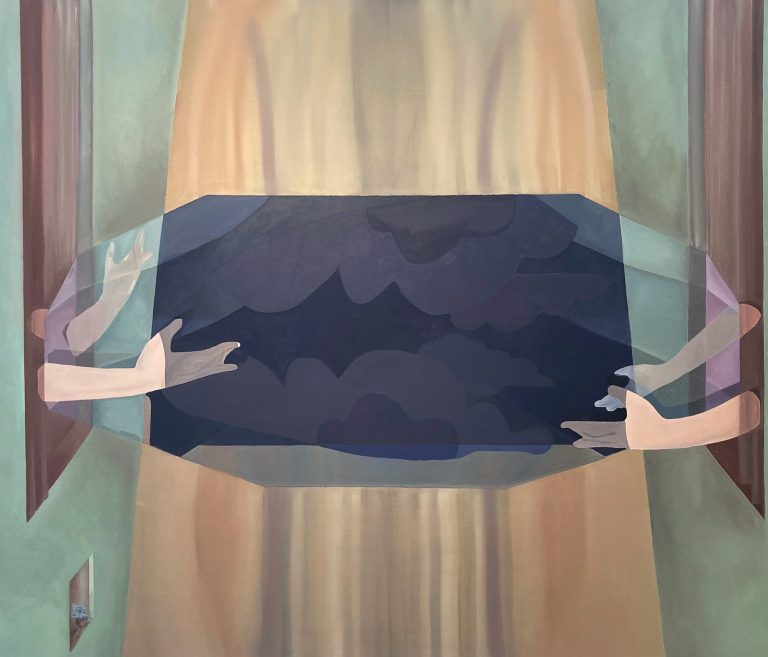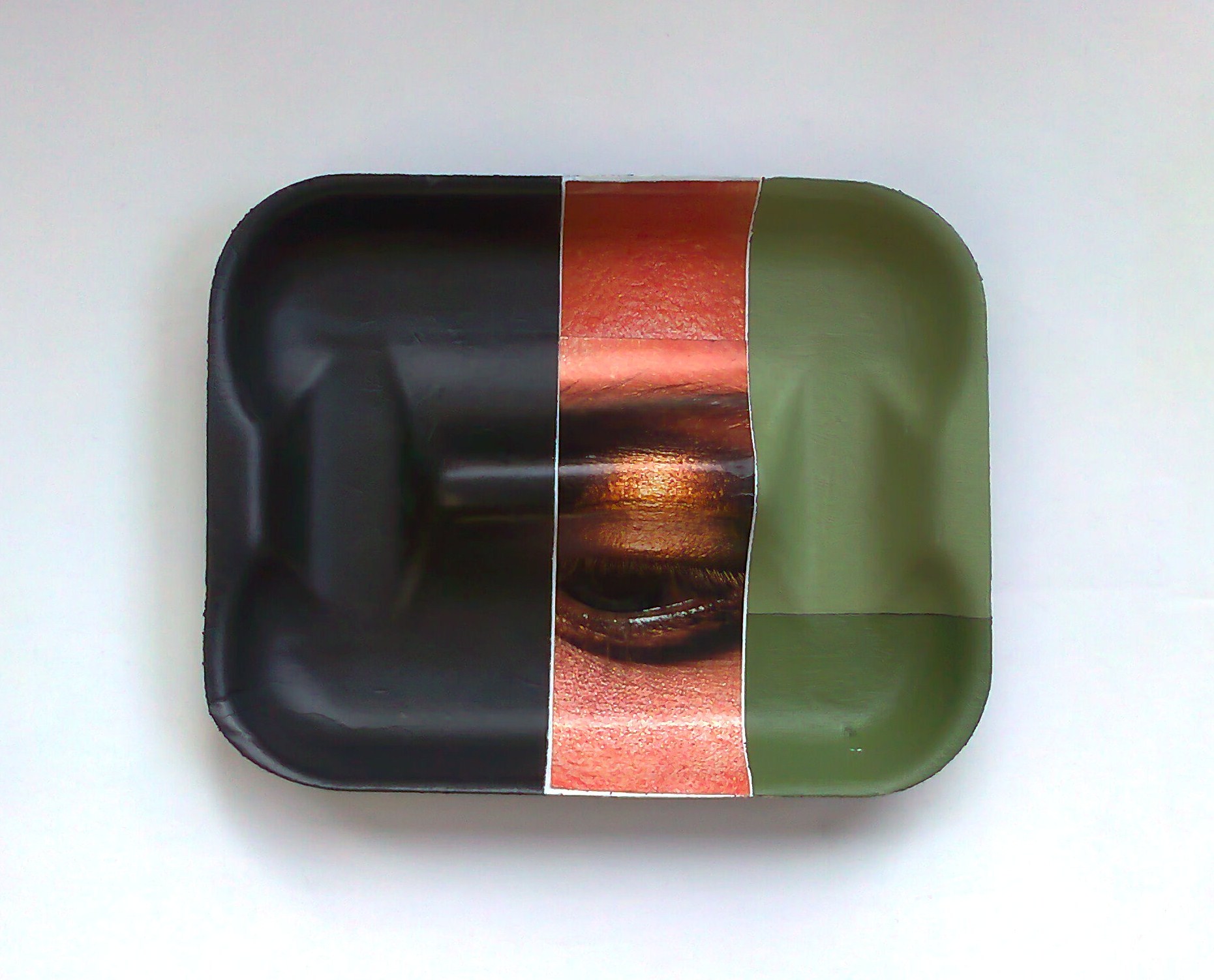Artists can be temperamental creatures, so we took things slowly at first. I started with Image 0737 and began by asking him to tell me how it came about — where and when it was taken.
I was wandering around the city one night when I came across this small alcove closed off by a set of bars. I hadn’t taken any images in a while — I’d become disillusioned with the image making process — and this alcove seemed to sum up how I was feeling at the time.
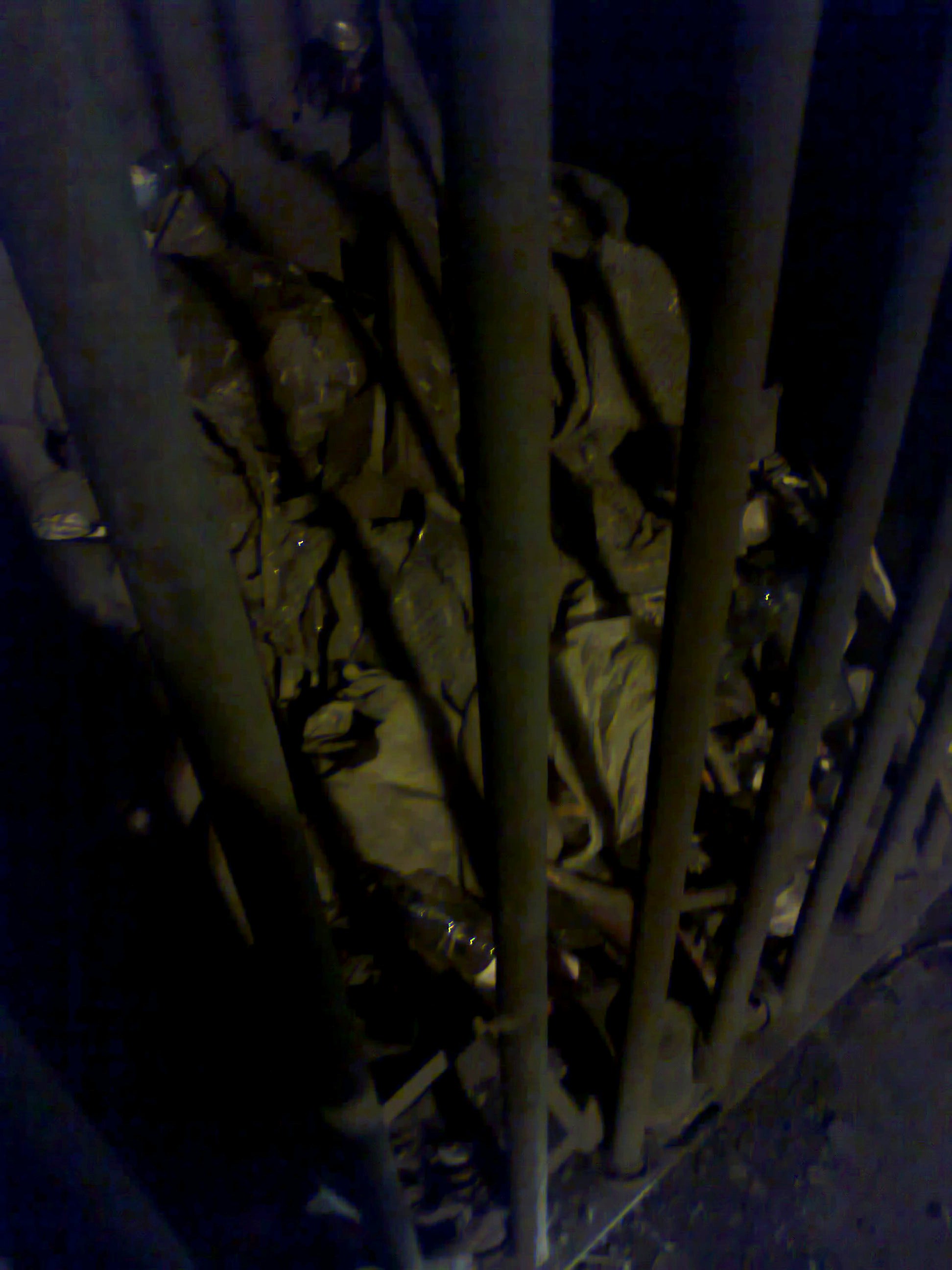
Image 0737
I asked him what the connection was between this image and the next image, 0674.
The mood is certainly lighter, almost celebratory in nature.
I asked him if it he could confirm it was sunlight, and if it was, what purpose it served in relation to the general lack of sunlight in Image 0737.
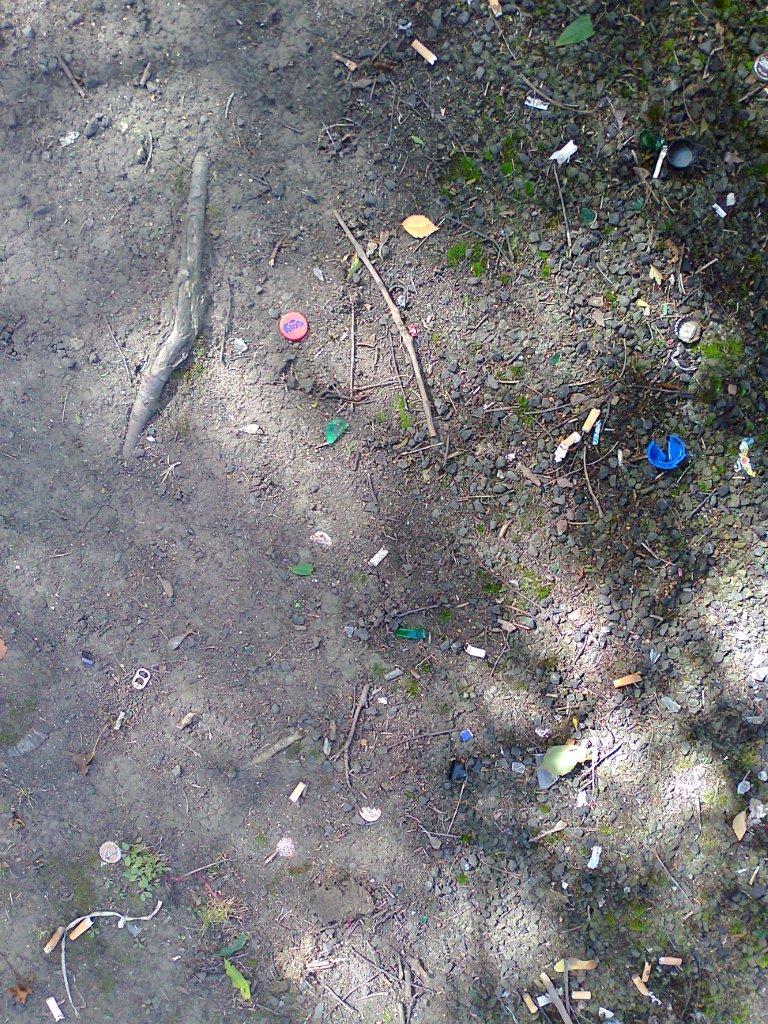
Image 0674
It appears to be sunlight all right, filtering through what looks like the branches of a tree.
He seemed reluctant to take ownership of the image so I asked him to tell me a little about the thinking behind it, to set the record straight, as it were. I asked him if we were in a park or a public space, or a garden of some sort. I did not say waste ground, though it was what was on my mind.
Actually, I don’t recognise the location.
He said he didn’t recognise where it was and had no memory of having taken the image. I reminded him that it had been found on his device.
Are you sure, because I have no recollection of having taken it? I may very well have taken it, of course, but as I say, I have no memory of taking it. I may have triggered my device accidentally. To me it could be anywhere. It’s during the day obviously, and the numerical sequence would seem to indicate that it was taken before the first image.
I asked him again if he recognised the location.
It might be St. Stephen’s Green or Herbert Park.
I wondered why he had mentioned these two parks in particular. There was a long silence before he answered.
I used to spend a lot of time in St. Stephen’s Green and in Herbert Park.
I told him that the image reminded me of the Garden of Remembrance. There was something about it—the discarded butts, the moss infested tarmac bleeding into the dusty ground. I put it to him that he might have triggered his device accidentally in the Garden of Remembrance.
I’m not ruling out the Garden of Remembrance — in fact it’s a favourite haunt of mine—but I don’t remember having visited it during this period.
We talked for a while about the Garden of Remembrance. He admired the design: the Children of Lir rising into the sky; the sunken cruciform with its trove of discarded weaponry. We agreed the facility was well maintained and attracted a large number of visitors. He said he thought the new entrance on its northern periphery had been a welcome addition.
We moved on to the next image and I asked him if we were dealing with something similar. Maybe I was on the wrong track, but it seemed to me that there were a number of similarities between this image and the one he may have taken accidentally in the Garden of Remembrance. I pointed these similarities out to him — the scattered leaves, the blue and orange bottle tops, the desiccated earth studded with shards and fragments. He agreed that the leaves in Image 0676 were like a withered wreath. But then there was that ominous band of shadow, reminiscent of a Mark Rothko painting, across the bottom of the image, what was that all about?
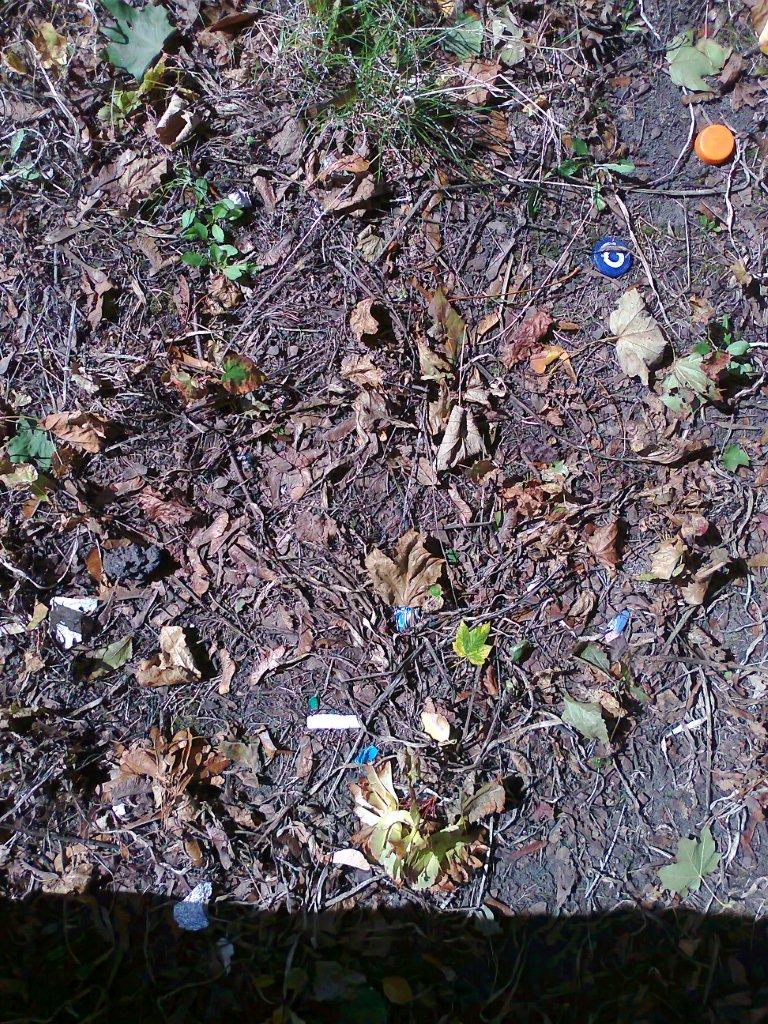
Image 0676
I asked him if he might shed some light on this image. It was then I realised there was an image missing, Image 0675. I wondered if he had by chance deleted it. He ignored my enquiry and spoke instead about the differences between Image 0674 and Image 0676.
In Image 0674 one of the bottle tops is fractured.
I pictured its blue carapace being twisted free and trampled into the earth.
It’s split down the middle and the central bottle top in Image 0674 is red, not orange.
I looked again at Image 0674. He was right, the bottle top — slightly left of centre — wasn’t orange, it was a washed-out red, its once pristine brilliance abraded through prolonged exposure to the elements to the colour of a pink carnation. There were scraps of something beneath it, scattered like fragments of an exploded balloon.
And there’s something written on it. Did you notice the upended black bottle top in the top right hand corner?
I looked at the image again. There was something written in blue on the faded pink bottle top but it was impossible to make out what it was. And how could I have missed the upended black bottle top in the top right hand corner? The yellow leaf to its left must have distracted me, along with the dusty root to the leaf’s left, making its way out of and back into the earth. Re-examining the image I noticed that, about midway between the black and blue tops, was an unassuming looking little top — like a spent bullet casing. One side of it was completely crushed. I didn’t mention this to him, but instead asked if he could make out what was written on the washed-out bottle top. He reply was illuminating.
Probably a logo of some sort.
When he said this, the phrases “Now do you see?” and ‘Now do you understand?’ came to mind. He became agitated when I mentioned this to him, and denied again having taken either of the images.
What has coloured bottle tops got to do with seeing and understanding?
I felt it had everything to do with them but for some reason I could not bring myself to say this to him. Instead, I asked him if he would care to speculate as to what happened to the missing image — 0765.
I must have deleted it.
I asked him if it was perhaps an image taken in the Garden of Remembrance. He said he didn’t think so — of course he couldn’t rule out the possibility. I said maybe the next image would help jog his memory. It was Image 073-001, or Straw Pool, as it’s now known.
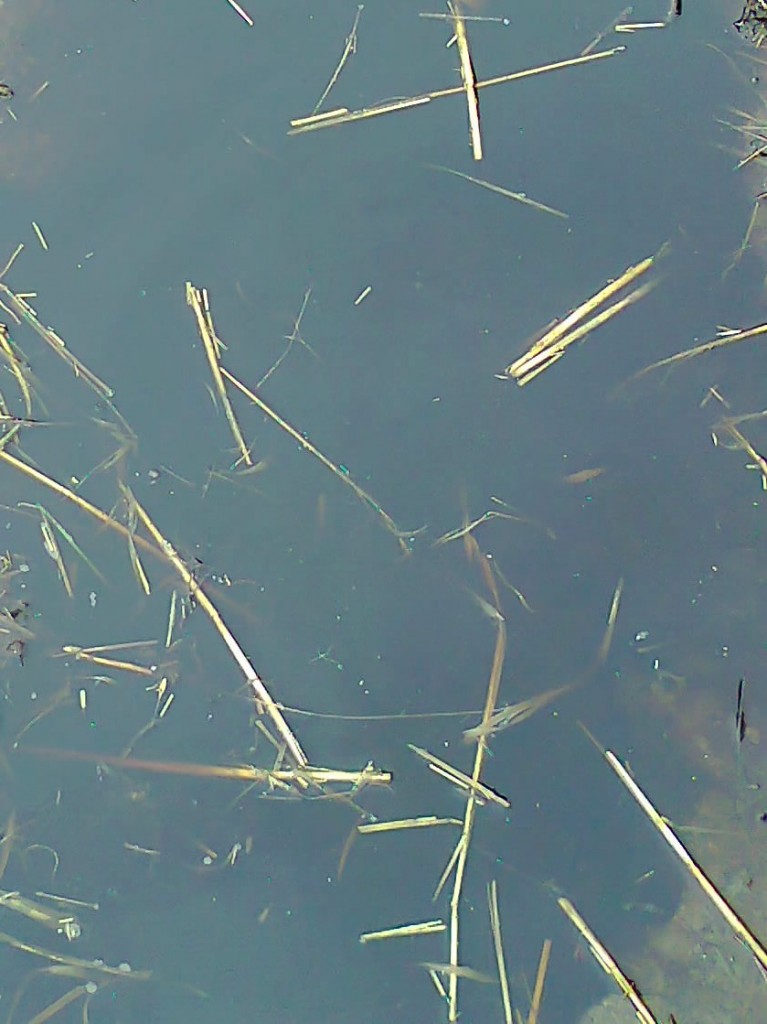
Image 073-001 (Straw Pool)
I wasn’t sure if he would recognise it. When I first mentioned the name Straw Pool to him he said, somewhat disdainfully, that he wasn’t in the habit of referring to the images by name.
To me they’re just images.
I asked him if he had a problem with it being calling Straw Pool. It was, after all, an image of a pool with straws in it.
There are other possibilities in terms of a title and the title’s relationship to the content.
I followed up by asking him if he felt uncomfortable with the name Straw Pool. Most of the straws are completely submerged in the liquid’s opacity. I stressed this point a number of times, without being too obvious. When he didn’t reply, I said that they being completely submerged wasn’t a good enough reason to find the name disturbing. I added that I hadn’t considered that he might find such a title disturbing, but that I didn’t see any useful alternative, considering the image was now known by that name. I told him any confusion regarding the image could have been easily cleared up by his simply accepting the title, Straw Pool. In the silence that followed, the thought of this image being stripped of its title left me with an unbearable feeling of sadness.
First of all I don’t find this title — Straw Pool — disturbing.
I said nothing for a few moments, then nodded and repeated the title by which the image was now known.
Straw Pool, yes, I don’t find it disturbing in the slightest. Quite the reverse, the straws are in a pool: suspended, submerged, immersed. So to answer your question, while I would prefer to keep the numerical reference, I’m happy to go along with this title, in fact I’m flattered that anyone would go to the trouble of titling one of these images. I’m equally flattered that the title has caught on.
Buoyed by this reply, I asked if he was surprised the title had caught on.
Not surprised, no.
I then told him that after examining the image in detail I felt that a majority of the straws were in fact not keeping their heads above water.
That the world exists entirely without hope — is that what you’re saying?
This answer threw me a bit. I lowered my voice and told him we were in this together. He ignored me and carried on with his extrapolation.
Within the image’s limited remit you could say a substantial number of the straws are remaining afloat. But there is no telling how many straws, outside the pool’s frame of reference, are partially or indeed wholly immersed. Let’s assume that there are straws that are not visible. So who knows the extent of their immersion, the depths to which they have sunk?
As he spoke, a trove of memories floated to the surface.
Equally, such a sunken state might represent a state of liberation. The assumption is that the straws exist in some sort of abject state, but it’s entirely possible that they will emerge unscathed and find themselves floating freely upon the pool’s opacity.
Encouraged by this display I steered him round to the question of what he had been attempting to achieve. Although unsure of whether or not I should encourage his interpretative flights of fancy, I recognised the necessity of pressing on towards a conclusion. But there was a belligerence in his voice that disturbed me, a defiance that seemed out of place.
With regard to my intention the question of accountability is neither here nor there. It is not my intention for you to come to any specific conclusions, beyond the fact that you must face up to the fact that you must —
I interrupted him here. His voice had become shrill. I wondered if it would ever be possible to fathom his intentions, to plumb the depths of what had consumed him. Once more an unbearable feeling of sadness washed over me.
In the course of my work I accumulate a large quantity of images, some of which are meaningful, some of which are not. The majority of these images have to be discarded, but a small minority emerge to define themselves outside of the process of exclusion and inclusion, images that seem to embody the possibility of bridging the gap between futility and utility, between what is intentional and what is not.
I was only half listening now — half remembering, half dreaming. It was beginning to dawn on me that Image 073-001 had been a turning point. The floating straws represented something he had been trying desperately to suppress, to keep beneath the surface. I wondered why he had chosen not to say anything about this to me, why he’d ignored the fact that a majority of the straws were not keeping their heads above water, but were, in fact, being forcibly held beneath the surface.
I think it was the opacity that attracted me. I can’t remember really. As I said I used to take hundreds of images in the course of my work.
Perhaps that’s why I was here, searching the wreckage, sifting shadows.
You have asked me a series of questions and I’ve tried to answer them as honestly as I can. I’ve told you that I may have been drawn to a certain image in order to make a connection of some sort. Beyond that I don’t know what more can I say.
We had arrived at the first set of sequences — Image 0746 to 0748. I knew now that there was no turning back, that I could never escape him. Wherever I looked one way or another, he’d always be there, hovering just out of reach.
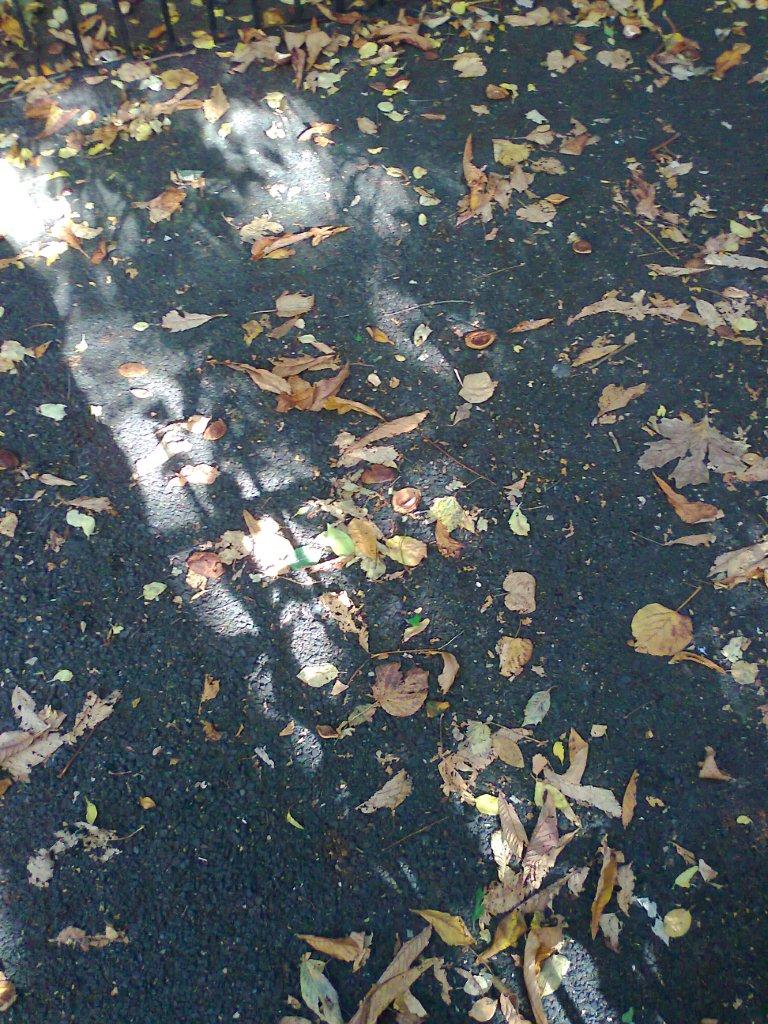
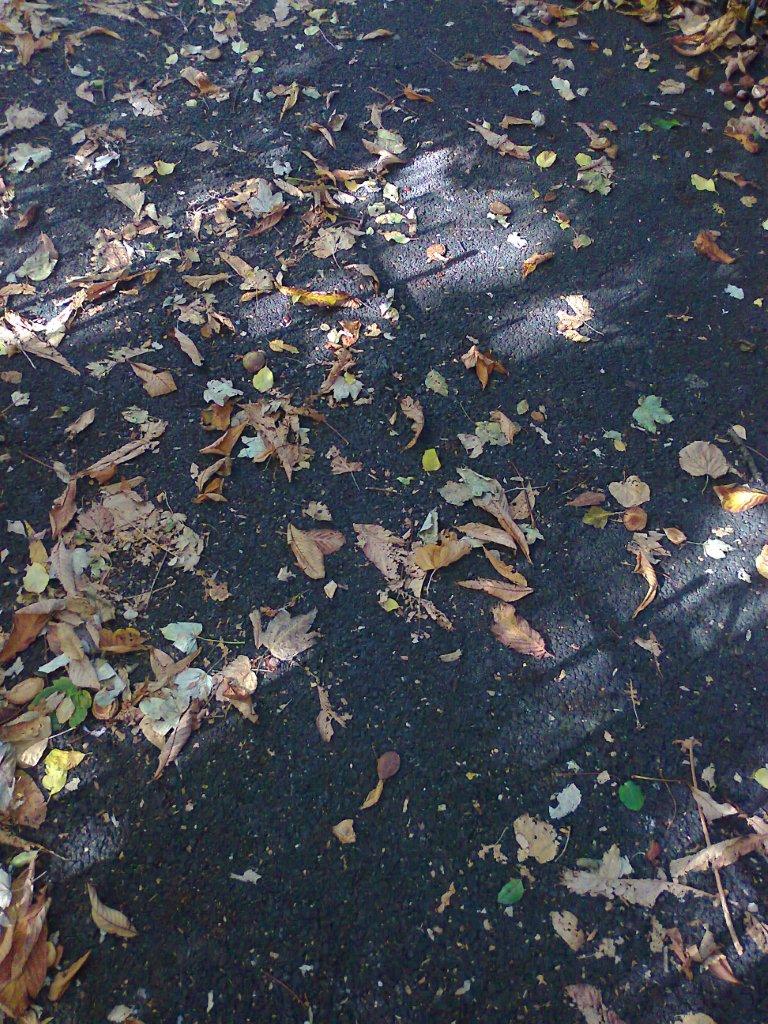
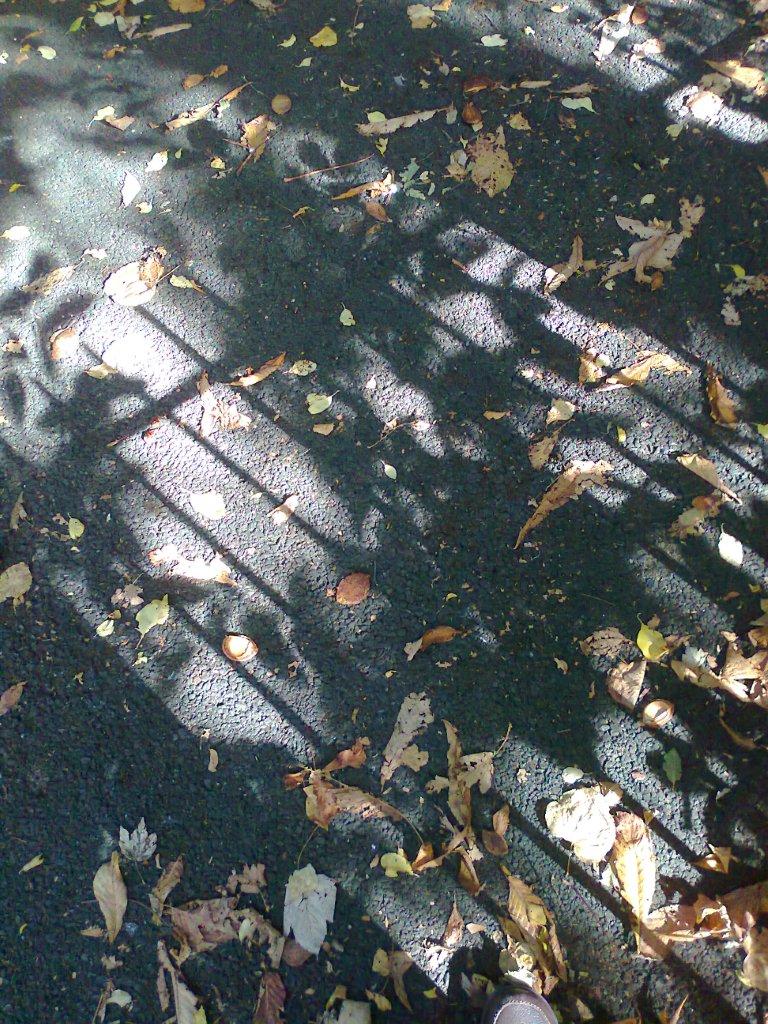
Image 0746, 0747, 0748
In the first sequence, the shadow of a linear structure diverges at right angles through a random scattering of leaves. The location in each frame is proximately similar. We are dealing with movements, with seasonal variation and the dynamics of light and shade as a way of saying something like: “Now do you see? Now do you understand?” The shadows are aligned in a herringbone pattern.
In relation to the overall design the railings function as a broken net. The net takes the form of a fish’s skeleton and configures the leaves as an indiscriminate scattering of scales. The light has a sunken feel to it, as if the sunlight were being sucked through the tarmac down into the earth.
I took the difference in numerical reference points — the four digit 0000 series and the binary six digit structure of the marginalised Straw Pool — as marking some form of transition, from bars to straws to the shadows of railings, shadows submerging straws, railings and bars returned to shadowy invisibility. There were a lot of dead leaves. The sequence is suffused with foreboding which indicates there might be a tree, or trees, overhead. I did not rule out the possibility that the leaves had been gathered elsewhere, transported to the site and placed randomly on the ground to give the impression of their having fallen above the dappled tarmac, from a tree, or trees.
The profusion of fish scales and the ruptures in the netting suggests a struggle of some sort.
We moved on quickly to the next sequence, this time involving a breaking wave. Its numerical reference — 0685 to 0687 — placed this sequence before Image 0737 and the preceding sequence 0746 to 0748, but after Image 0674 and 0676. The railings in the sequence have emerged from the shadows and take the form of handrails running either side of a series of stone steps down into the sea. The railings terminate somewhere beneath the waves.
The initial image [0737] posited the idea of something behind bars. In this sequence the bars have been beaten, not into ploughshares and pruning hooks, but handrails.
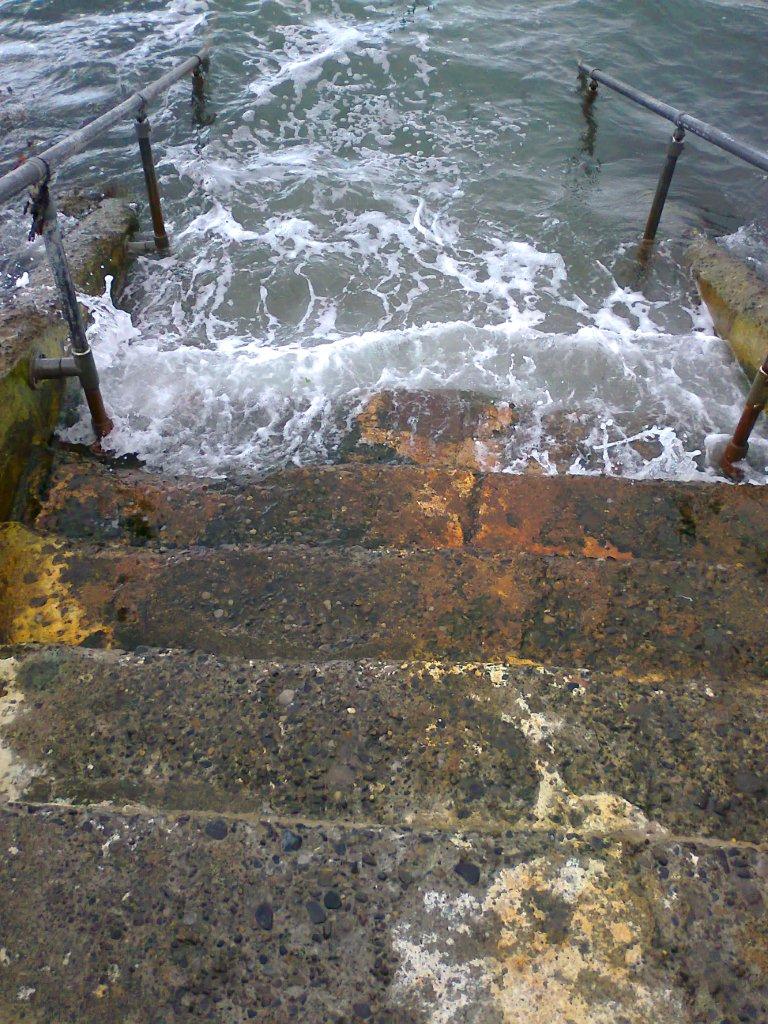
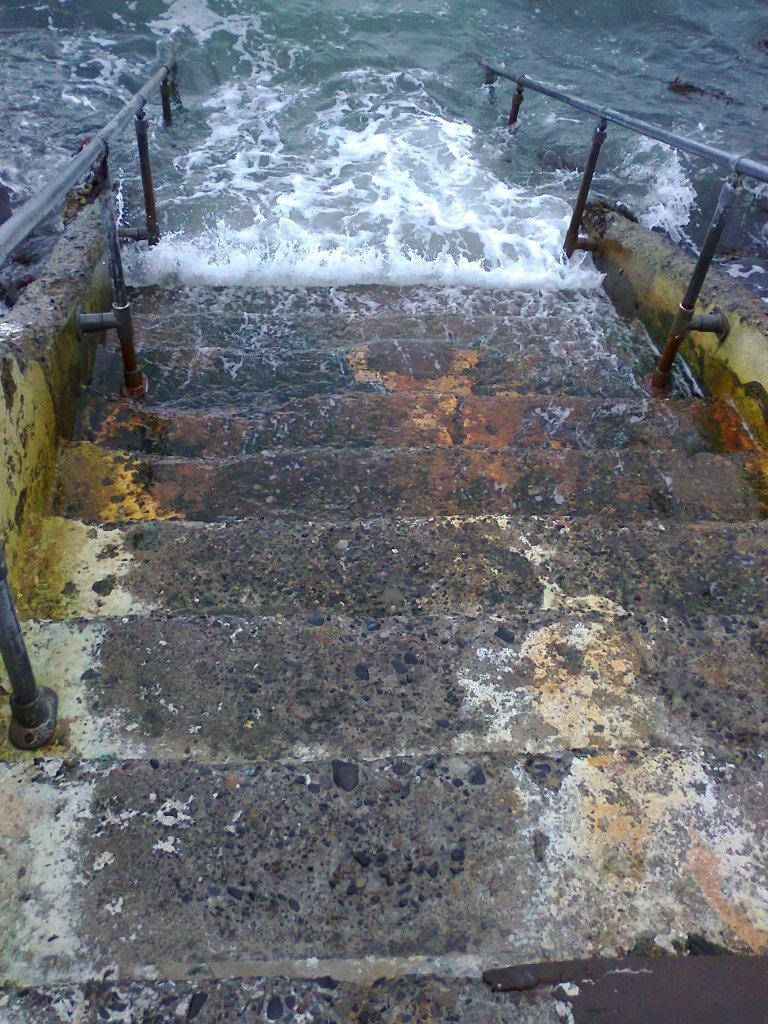
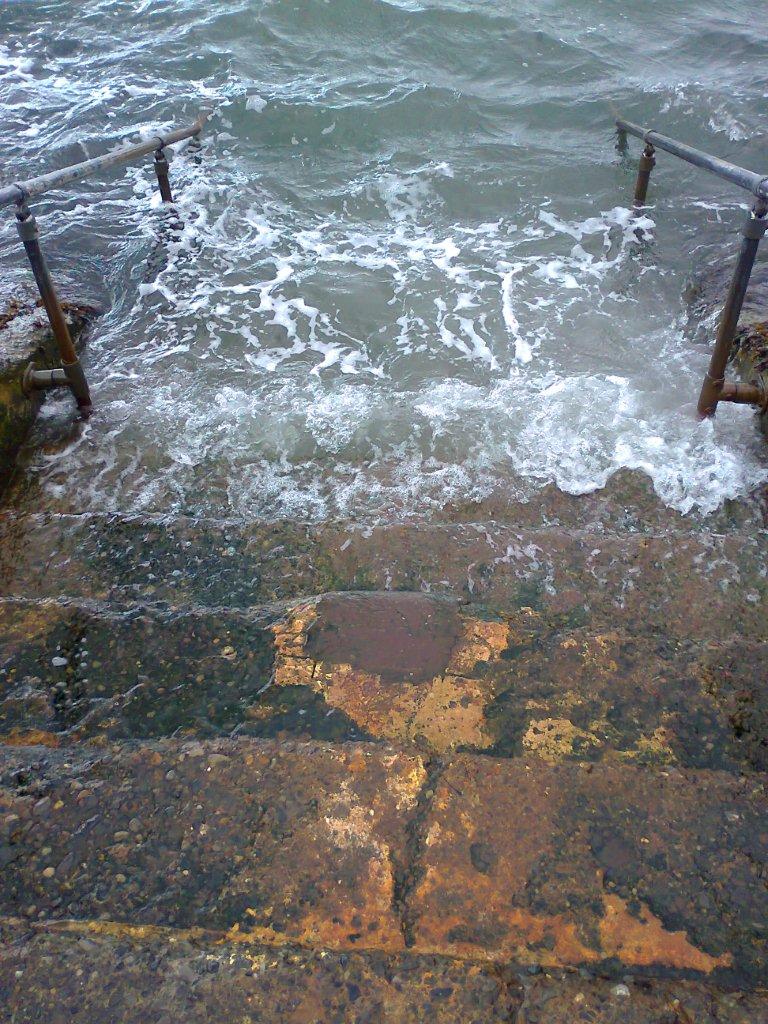
Image 0685, 0686, 0687
He said he took the images, one after the other, in quick succession — like gasping for breath.
There was no intention at the time to connect the images, to place them in a sequence – in and out and in again. Neither did I time the taking of the images to coincide with the advancement and recession of the water.
I knew now that there had been a purpose to his choices, that he had not simply been selecting images at random and scattering them like leaves before my emaciated gaze.
There was an intention, a desire on my part that existed outside of my control, to capture this convergence, these violent convulsions.
I agreed that the sequence represented a form of undelineated desire. There is a roughness inherent in such acts of capture; an aggressive taking away. It was there in the weathered steps and the handrails running into the sea.
I suppose there might be some correlation, yes, but I have no memory of wanting to place these images in a sequence. It was the back and forth, the painstaking erosion of the stone, that drew me in.
I thought of the handrails, terminating under the waves as he gasped for breath.
The handrails enter the waves as they break. They are seen and then unseen, covered and then uncovered, like a revelation. I was taken in and pulled towards it. Any intention I had was secondary to my helplessness before that act of annihilation.
I wanted to ask him about this helplessness because it seemed we were back where we’d started, with Image 0737, and all the things that can only be seen in the dead of night, things that reveal themselves dimly and when we least expect it.
Benjamin Robinson is a writer and visual artist. His work has been published most recently in ART From ART – A Collection of Short Stories Inspired by Art (Modernist Press); on-line at 3:am Magazine, Puerto Del Bloga, and recirca.com. He lives in Dublin.

